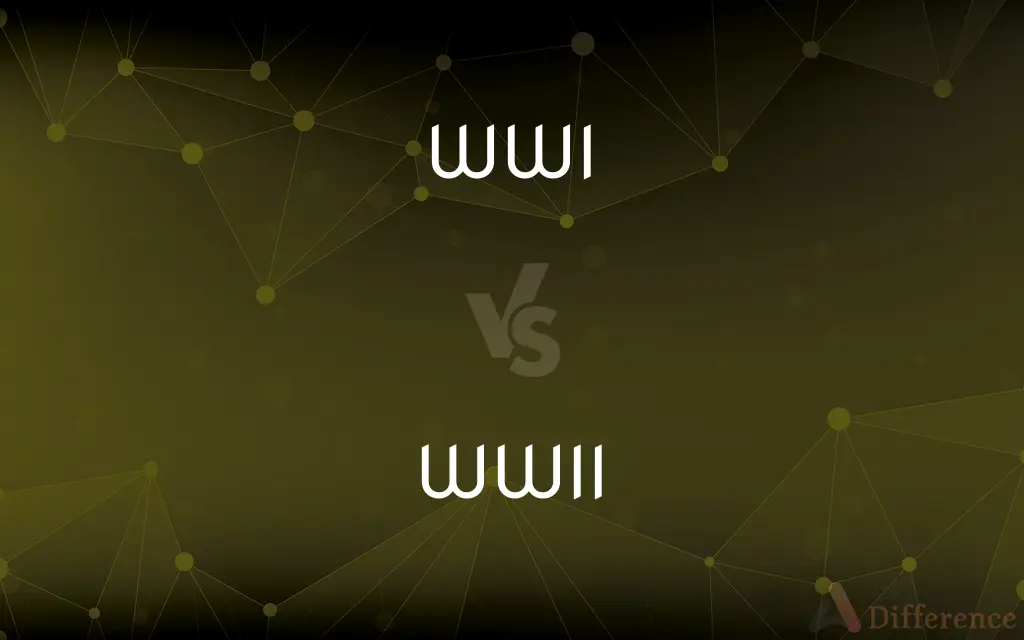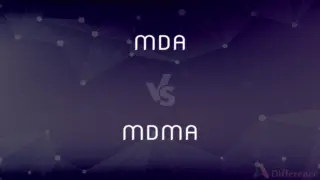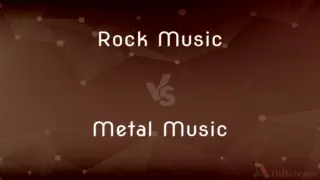WWI vs. WWII — What's the Difference?
By Tayyaba Rehman — Published on January 24, 2024
WWI (World War I, 1914-1918) was a global war centered in Europe, sparked by national rivalries and alliances, while WWII (World War II, 1939-1945) involved more nations and was marked by ideological conflicts, including fascism versus democracy.

Difference Between WWI and WWII
Table of Contents
ADVERTISEMENT
Key Differences
World War I (WWI), occurring from 1914 to 1918, was triggered by the assassination of Archduke Franz Ferdinand and was characterized by trench warfare and a battle over European alliances. World War II (WWII), spanning from 1939 to 1945, began with Germany's invasion of Poland, and was notable for its global scale and the involvement of major powers like the USA and USSR.
WWI was marked by static frontlines, particularly on the Western Front, and witnessed the introduction of modern warfare technologies like tanks and chemical weapons. WWII saw a significant advancement in military technology, including the use of nuclear weapons, and was characterized by more dynamic and widespread warfare, including significant air and naval battles.
The end of WWI led to significant political changes in Europe, including the dissolution of empires and the Treaty of Versailles, which imposed harsh penalties on Germany. WWII concluded with profound global impact, leading to the emergence of the United States and the Soviet Union as superpowers, the beginning of the Cold War, and the establishment of the United Nations.
WWI had complex causes, including nationalism, militarism, and a system of alliances, which turned a regional conflict into a world war. WWII was largely driven by the aggressive expansionist policies of Nazi Germany, Fascist Italy, and Imperial Japan, rooted in ideologies of fascism and imperialism.
The aftermath of WWI sowed the seeds for WWII, with economic hardship and political instability in Germany contributing to the rise of Hitler and the Nazi Party. Post-WWII, the world saw the division of Europe and the onset of the Cold War, as well as significant movements for decolonization in Asia and Africa.
ADVERTISEMENT
Comparison Chart
Duration
1914-1918
1939-1945
Key Trigger
Assassination of Archduke Franz Ferdinand
Germany's invasion of Poland
Warfare Style
Trench warfare, early tanks and chemical weapons
Advanced technology, nuclear weapons
Political Consequences
Treaty of Versailles, fall of empires
Emergence of superpowers, Cold War onset
Driving Ideologies
Nationalism, militarism, alliances
Fascism, imperialism, democracy vs. totalitarianism
Compare with Definitions
WWI
Trench Warfare: Characterized by extensive trench systems.
Trench warfare in WWI led to high casualties and stalemates.
WWII
Post-War Impact: Led to the establishment of the United Nations and the Cold War.
The end of WWII marked the beginning of the Cold War era.
WWI
European Alliances: Involved a complex web of European alliances.
The alliance system was a key factor in the escalation of WWI.
WWII
Holocaust and Genocide: Included the Holocaust and other genocides.
The Holocaust was one of the most horrific aspects of WWII.
WWI
Technological Advancements: Saw the introduction of tanks and chemical weapons.
WWI was notable for the first significant use of tanks in warfare.
WWII
Ideological Conflict: Fought between the Axis and Allied powers.
WWII was marked by the struggle against fascism.
WWI
Political Repercussions: Led to the redrawing of borders and the Treaty of Versailles.
The Treaty of Versailles, post-WWI, imposed harsh terms on Germany.
WWII
Global War (1939-1945): The most widespread war in history.
WWII involved more countries than any other war.
WWI
Global Conflict (1914-1918): First major international war of the 20th century.
WWI fundamentally changed global politics and warfare.
WWII
Advanced Warfare: Featured significant advancements in military technology.
WWII saw the first use of nuclear weapons in combat.
Common Curiosities
What started WWI?
WWI began with the assassination of Archduke Franz Ferdinand of Austria-Hungary in 1914.
How long did WWII last?
WWII lasted from 1939 to 1945.
What were the global impacts of WWII?
WWII resulted in the emergence of the USA and USSR as superpowers and set the stage for the Cold War.
How long did WWI last?
WWI lasted from 1914 to 1918.
Was the use of chemical weapons more prevalent in WWI or WWII?
Chemical weapons were more commonly used in WWI.
What triggered WWII?
WWII was triggered by Germany's invasion of Poland in 1939.
Which countries formed the Central Powers in WWI?
The Central Powers in WWI included Germany, Austria-Hungary, the Ottoman Empire, and Bulgaria.
What was the main style of combat in WWI?
Trench warfare was the dominant style of combat in WWI.
What technological advancements were made in WWII?
WWII saw advancements like radar, jet engines, and nuclear weapons.
How did the end of WWI differ from the end of WWII?
WWI ended with treaties like Versailles, while WWII concluded with total defeat of the Axis Powers and significant post-war restructuring.
What were the political outcomes of WWI?
WWI led to the redrawing of borders in Europe and the Middle East, and the Treaty of Versailles.
How did warfare tactics differ between WWI and WWII?
WWI was characterized by trench warfare and stalemates, while WWII involved more mobile and diverse warfare tactics, including significant air and naval battles.
Did WWI directly lead to WWII?
The consequences of WWI, especially the Treaty of Versailles, directly contributed to the conditions leading to WWII.
What role did the USA play in WWI and WWII?
The USA entered WWI in 1917, aiding the Allies, and was a major force from the beginning of its involvement in WWII in 1941.
Who were the Axis Powers in WWII?
The Axis Powers in WWII were primarily Germany, Italy, and Japan.
Share Your Discovery

Previous Comparison
MDA vs. MDMA
Next Comparison
Rock Music vs. Metal MusicAuthor Spotlight
Written by
Tayyaba RehmanTayyaba Rehman is a distinguished writer, currently serving as a primary contributor to askdifference.com. As a researcher in semantics and etymology, Tayyaba's passion for the complexity of languages and their distinctions has found a perfect home on the platform. Tayyaba delves into the intricacies of language, distinguishing between commonly confused words and phrases, thereby providing clarity for readers worldwide.
















































